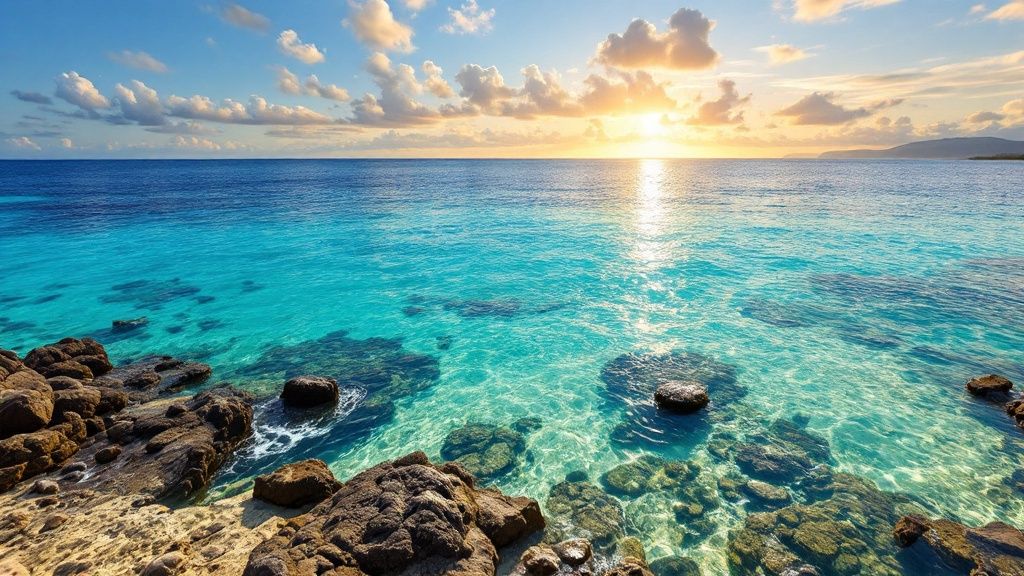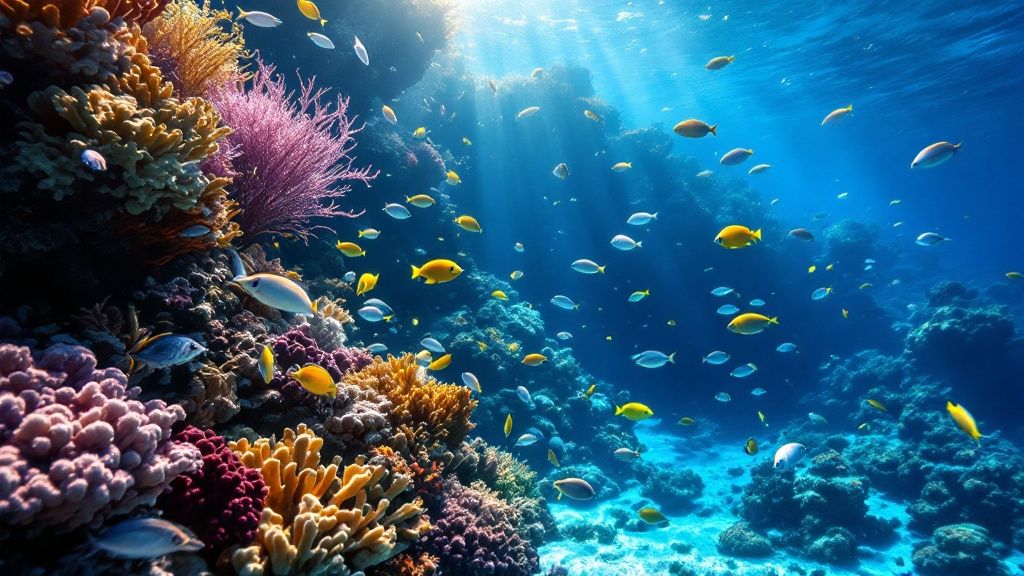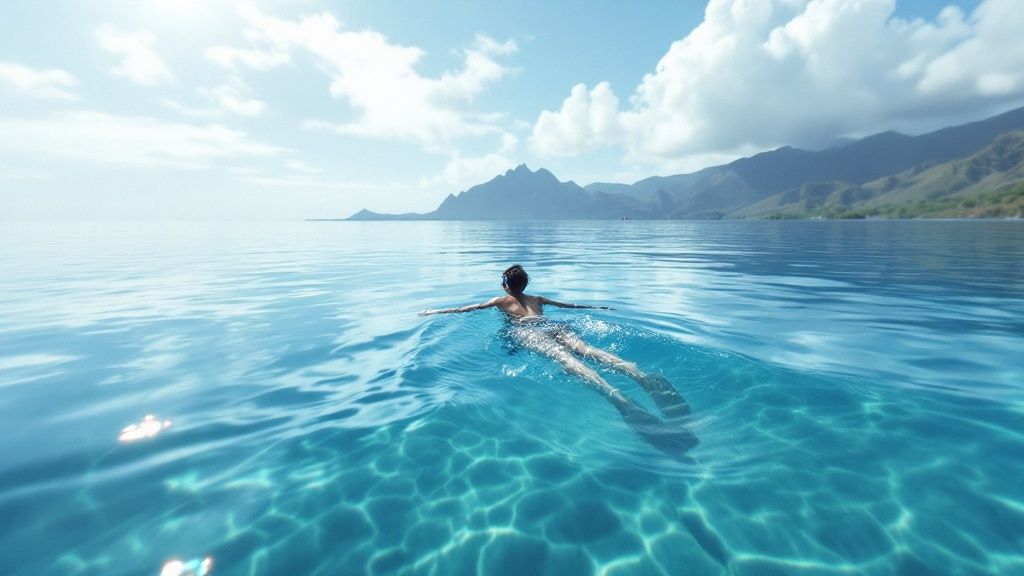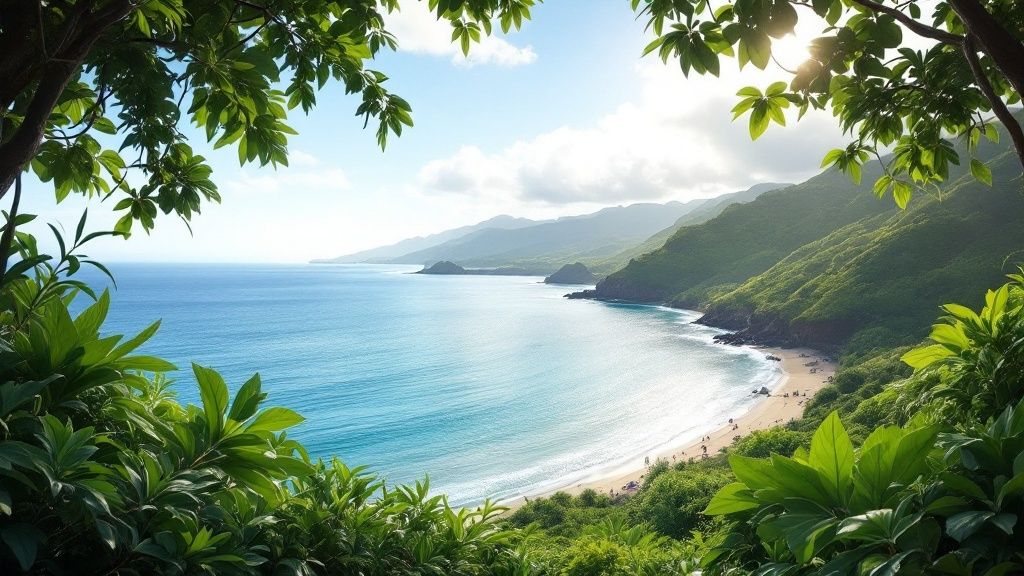Snorkeling Kealakekua Bay - Dive in for Underwater Magic
- Kona Snorkel Trips
- Mar 28
- 11 min read
Why Snorkeling Kealakekua Bay Will Transform Your Hawaii Trip
Let's face it: not all snorkeling experiences are created equal. Kealakekua Bay isn't just another spot; it's a Marine Life Conservation District consistently ranked among Hawaii's best. What sets it apart? The unique blend of history, geology, and vibrant marine life.
Kealakekua Bay holds profound historical significance as Captain Cook's landing site. This backdrop adds a layer of depth, transforming the snorkeling experience into an exploration of both natural wonders and human history. You might be interested in: Our blog post sitemap for more insights into this fascinating location.
The bay's unique geological formation creates an ideal environment for marine life. The sheltered nature combined with specific current patterns provides perfect conditions for coral reef development. This leads to exceptional water clarity and a breathtaking array of marine species.
An Underwater Paradise Teeming With Life
This translates into spectacular visibility, often exceeding 100 feet, and remarkable biodiversity. Imagine drifting through crystal-clear water, surrounded by schools of colorful reef fish and graceful sea turtles. The bay boasts a rich population of Hawaiian green sea turtles, playful spinner dolphins, and even the occasional monk seal.
Balancing Popularity and Preservation
Kealakekua Bay attracts over 190,000 visitors annually, making it a popular snorkeling destination. This popularity is a testament to the bay's unique appeal, but also raises concerns about environmental impact.
The high volume of visitors can contribute to issues like inappropriate anchoring and disturbance of marine life. Despite these challenges, the bay remains a prime location for snorkeling. Its designation as a marine life conservation district aims to protect its fragile ecosystem. Learn more about the bay's conservation efforts here.
Setting Realistic Expectations for Your Adventure
While Kealakekua Bay promises an unforgettable snorkeling experience, it's important to set realistic expectations. Conditions can vary depending on the time of year and weather patterns. However, with a little preparation and respect for the environment, snorkeling Kealakekua Bay will undoubtedly be a highlight of your Hawaiian adventure. The bay’s captivating beauty and rich marine life offer a truly memorable experience, making it a must-see destination for any visitor to the Big Island.

The Underwater Residents You'll Meet at Kealakekua Bay
Snorkeling in Kealakekua Bay isn't just about dipping below the surface. It's about entering a vibrant underwater world teeming with life. This bay's protected status as a Marine Life Conservation District makes it a haven for diverse marine species. It's not your average snorkeling spot.

Colorful Characters of the Reef
Prepare to be mesmerized by schools of yellow tangs, their brilliant color a stark contrast against the deep blue. These iconic reef fish are a common sight, often swarming in large numbers. You'll also want to keep an eye out for the graceful Hawaiian green sea turtles.
These gentle giants glide effortlessly through the coral gardens and are a highlight for many snorkelers. They are a truly memorable sight.
Elusive Encounters and State Symbols
With a little patience, you might even spot the elusive Hawaiian monk seal. These endangered creatures occasionally visit the bay, offering a truly special encounter. And don't forget to look for Hawaii's state fish, the humuhumunukunukuapua'a, with its distinctive markings and unique name.
For more information on Hawaiian marine life, you might be interested in our sitemap. It contains additional resources about the diverse species found in Hawaiian waters.
A Thriving Underwater Neighborhood
Kealakekua Bay has an average depth of about 25 feet, but it can reach depths of up to 153 feet in some areas. This depth range, combined with excellent visibility, often up to 100 feet, makes it ideal for observing a variety of marine life. You can explore this topic further here.
This clarity, combined with the bay's protected status, contributes to a thriving underwater ecosystem unlike anywhere else in Hawaii. It's a truly special place to experience the beauty of the Pacific Ocean.
Seasonal Sightings and Strategic Locations
The time of year you visit Kealakekua Bay can influence which marine species you encounter. Certain fish may be more abundant during specific seasons. Other creatures, like humpback whales, are only present during the winter months.
Even within the bay itself, different species congregate in specific areas. Understanding these patterns will maximize your chances of spotting specific marine life and capturing memorable underwater encounters.
The following table provides a glimpse into some of the common marine species you might encounter while snorkeling in Kealakekua Bay:
Common Marine Species at Kealakekua Bay: A comprehensive list of marine species frequently spotted while snorkeling Kealakekua Bay, including where they're typically found and best viewing times.
Species | Description | Best Viewing Location | Frequency of Sightings |
|---|---|---|---|
Yellow Tang | Bright yellow, oval-shaped reef fish, often seen in large schools | Shallow reef areas | Very Common |
Hawaiian Green Sea Turtle | Large, gentle sea turtles that graze on algae | Coral gardens and seagrass beds | Common |
Hawaiian Monk Seal | Endangered seal species, occasionally seen resting on the shore or swimming in the bay | Near the shoreline or deeper waters | Rare |
Humuhumunukunukuapua'a (Reef Triggerfish) | Hawaii's state fish, recognizable by its distinctive markings and beak-like mouth | Coral reefs and rocky areas | Common |
Butterflyfish | Various species of brightly colored butterflyfish | Coral reefs | Common |
Surgeonfish | Includes various species like tangs and unicornfish | Reef flats and slopes | Common |
Moray Eel | Eels that inhabit crevices and holes in the reef | Rocky areas and coral heads | Occasional |
This table highlights the diversity of marine life that calls Kealakekua Bay home. From the commonly sighted yellow tang to the rare Hawaiian monk seal, there's always something to discover in this underwater paradise. Planning your snorkeling trip around the best viewing locations and times will enhance your chances of encountering these fascinating creatures.
Navigating Your Way to Kealakekua's Hidden Treasures

Kealakekua Bay, a haven for snorkelers, offers breathtaking underwater experiences. But getting to the best spots requires a bit of planning. This section breaks down the three main access methods: boat tours, kayaking, and hiking. Each offers a unique perspective on this beautiful bay.
Boat Tours: Smooth Sailing to Snorkeling Bliss
Boat tours are undoubtedly the easiest way to access Kealakekua Bay's snorkeling gems. They whisk you away to the prime locations without any physical effort. This convenience makes them ideal for families and first-time visitors. However, it's essential to understand that not all tours are equal.
Some tours offer basic transportation, while others provide a more comprehensive experience. Consider what each tour includes beyond just the boat ride.
Pros: Convenient, no physical exertion, often include snorkeling gear and guides.
Cons: Can be pricier, less freedom to explore at your own pace.
Fair Wind Cruises offers tours with amenities like water slides and meals, while Dolphin Discoveries focuses on smaller groups and faster transport. Choosing the right boat tour depends on your priorities and budget.
Kayaking: Paddle Your Own Adventure
Kayaking offers an unparalleled level of flexibility. You set the pace, exploring different parts of the bay and lingering at your favorite snorkeling spots. Imagine paddling near the Captain Cook Monument and then venturing to a secluded cove for a quieter experience.
Pros: Explore independently, close interaction with the water, generally more affordable than boat tours.
Cons: Requires physical exertion and paddling skills, may require permits, and involves transporting your kayak.
Permits are sometimes required for kayaking in Kealakekua Bay. Renting from approved vendors like Ehu & Kai or Kona Boys often streamlines the permit process. Remember to factor in the paddling time, which can be around 30 minutes each way depending on conditions.
Hiking the Ka'awaloa Trail: A Trek to Treasure
For the budget-conscious adventurer, the Ka'awaloa Trail provides free access to Kealakekua Bay. However, this comes with a challenging 1.8-mile hike each way, featuring an elevation change of over 1,400 feet.
Pros: Free access, chance to explore the Captain Cook Monument area on land.
Cons: Strenuous hike, requires bringing your own snorkeling gear, time-consuming, adding over two hours to your snorkeling trip.
The trail is steep and rocky, so proper footwear and plenty of water are essential. The scenic views are rewarding, but the hike's difficulty makes it unsuitable for those with mobility issues. Sun protection is also crucial due to the lack of shade.
To help you choose the best access method for your needs, the following table provides a comparison:
To help you choose the best access method for your snorkeling adventure at Kealakekua Bay, we've compiled this comparison table:
Comparing Access Options for Kealakekua Bay A side-by-side comparison of the different methods to access snorkeling spots at Kealakekua Bay, including costs, permits, and pros/cons
Access Method | Approximate Cost | Permit Required | Pros | Cons | Best For |
|---|---|---|---|---|---|
Boat Tour | $100-$200 | No | Convenient, easy access, often includes gear and guides | More expensive, less flexibility | Families, those seeking convenience, first-time visitors |
Kayaking | $50-$100 | Sometimes | Flexible exploration, closer to the water, more affordable | Requires physical exertion, may need permit | Active individuals, experienced snorkelers, budget-conscious travelers |
Hiking | Free | No | Free access, land exploration | Strenuous hike, must bring gear, time-consuming | Fit adventurers, budget travelers |
As you can see, each access method has its own set of advantages and disadvantages. Choosing the right one depends on your fitness level, budget, and what kind of experience you're looking for.
Ethical Dolphin Encounters While Snorkeling Kealakekua Bay

Kealakekua Bay isn't just a beautiful underwater world; it's a crucial resting spot for spinner dolphins. These amazing creatures depend on the bay's tranquil waters for daytime rest. This means snorkeling in Kealakekua Bay calls for a respectful and considerate approach. Responsible interactions help ensure the dolphins' well-being and their presence in the bay for future generations.
Respecting the Dolphins' Rest
Spinner dolphins use Kealakekua Bay as a refuge to recover from their nightly hunts. During the day, they engage in important resting behaviors, essential for their health and survival. Human interaction can disrupt these vital rest periods, creating stress and affecting their natural rhythms.
Loud noises and sudden movements, for example, can easily startle the dolphins and interrupt their much-needed rest. This emphasizes the importance of thoughtful snorkeling practices. In Kealakekua Bay, dolphins are spotted on roughly 45.9% of observation days, mainly resting in Zone B, their primary rest area.
Swimmers and kayakers are often seen within 50 meters of the dolphins, sometimes disturbing their crucial rest. This highlights the need for responsible tourism to protect these incredible marine mammals. Discover more about dolphin behavior and human impact here.
Meaningful Observation: A Better Approach
Instead of pursuing close-up encounters, consider respectful observation. Position yourself quietly in the water and allow the dolphins to approach you, if they so choose. This provides a more rewarding and ethical experience.
Understanding stress signals is also essential. If dolphins display signs of distress, such as quick changes in direction or heightened vocalizations, it's vital to give them space. Learn more about our tours on our product sitemap.
Responsible Snorkeling Practices
Meaningful encounters don't necessitate close proximity. Observing dolphins from a distance, perhaps with binoculars, allows you to appreciate their natural behavior without interference. This approach ensures your snorkeling trip benefits the bay's delicate ecosystem instead of causing harm. Respecting the dolphins' space helps ensure a more sustainable future for them and this extraordinary environment.
Here are some key tips for respectful dolphin encounters:
Maintain a Safe Distance: Respect their rest by keeping your distance.
Observe Quietly: Minimize noise and splashing to avoid disturbance.
Recognize Stress Signals: Give them space if they appear agitated.
Passive Observation: Let the dolphins initiate contact, if they wish.
Capture Memories Responsibly: Utilize zoom lenses instead of chasing close-ups.
By following these simple guidelines, you can ensure your snorkeling adventure in Kealakekua Bay becomes a positive contribution to the well-being of these remarkable animals.
Essential Gear and Safety Strategies for Kealakekua Success
Planning a snorkeling trip to Kealakekua Bay requires more than just packing your mask and fins. Understanding the bay's unique characteristics and having the right gear and knowledge will ensure a safe and unforgettable adventure. This includes everything from selecting appropriate equipment to understanding emergency procedures.
Gear Up for an Unforgettable Experience
The right snorkeling gear can significantly enhance your comfort and enjoyment. For instance, a low-volume mask with a tight seal reduces the need for frequent clearing. Likewise, fins designed for different current strengths will improve your navigation in Kealakekua Bay.
Mask: Choose a low-volume mask for improved visibility and easier clearing.
Snorkel: A well-fitted dry snorkel will keep water out, making breathing more comfortable.
Fins: Select fins appropriate for the predicted currents. Shorter fins are suitable for calmer conditions, while longer fins provide more power in stronger currents.
Rash Guard/Wetsuit: Offers sun protection and warmth, especially during the colder months.
In addition, using reef-safe sunscreen protects your skin and the fragile coral reef. Many local guides also suggest wearing a rash guard or wetsuit for added sun protection and warmth. Check out our store products sitemap for more information on suitable gear.
Navigating Kealakekua Bay's Currents and Conditions
Kealakekua Bay's currents can vary with the seasons. It's important to be mindful of these changes and choose entry and exit points that minimize contact with sharp coral. The southern part of the bay, for example, tends to be calmer during the winter months.
Entry/Exit Points: Choose locations with sandy bottoms or designated entry/exit points to avoid damaging the coral.
Current Awareness: Monitor the current's strength and direction. If you find yourself drifting too far out, swim parallel to the shoreline until you reach calmer waters.
Changing Conditions: Be prepared for unexpected weather shifts. Darkening skies, increased wind, or choppy water signal that it's time to head back to shore.
Knowing the location of nearby medical facilities and communication options is also crucial, especially in areas with limited cell phone reception. Having a plan in place ensures you're ready for any unanticipated events.
Safety First: Essential Protocols for a Smooth Snorkel
Beyond gear and conditions, following basic safety procedures contributes to a worry-free snorkeling experience. This includes always snorkeling with a partner and remaining within designated areas.
Buddy System: Never snorkel alone. A buddy can provide assistance in case of an emergency.
Designated Areas: Stay within marked snorkeling zones and avoid areas with boat traffic or strong currents.
Hydration: Dehydration can affect judgment and increase the risk of cramps. Drink plenty of water before, during, and after snorkeling.
Emergency Plan: Familiarize yourself with emergency procedures and the location of the nearest first aid station.
By following these essential gear and safety strategies, you can confidently discover the wonders of Kealakekua Bay and create lasting memories of your snorkeling adventure. Proper preparation transforms a potentially hazardous outing into a safe and enriching underwater exploration. This knowledge will help you appreciate the bay’s beauty while minimizing potential dangers.
Connecting With Kealakekua's Cultural and Natural Legacy
Kealakekua Bay isn't just a beautiful snorkeling destination; it's a place where Hawaiian culture and natural beauty intertwine. Long before Captain Cook's arrival in 1779, this bay held deep spiritual significance for Hawaiians, and understanding this history adds another dimension to your snorkeling adventure.
A Sacred Place: Understanding Kealakekua's History
For centuries, Kealakekua Bay served as a place of spiritual importance for Hawaiians. It was a Pu'uhonua, a sanctuary of refuge for those who broke kapu (sacred laws). Imagine seeking solace and forgiveness in this tranquil bay, surrounded by dramatic cliffs and vibrant marine life. This historical context transforms a simple snorkeling trip into a journey through time, connecting you with the rich heritage of this special place. Learn more in our article about our site offerings.
Conservation Challenges and Innovative Solutions
Today, Kealakekua Bay faces modern challenges. Coral bleaching, driven by rising ocean temperatures, threatens the delicate reef ecosystem. Water quality issues, often stemming from land-based pollution, also impact the bay's health.
However, innovative management approaches are addressing these threats. Community-based monitoring programs, for example, involve local residents in collecting data on water quality and coral health. This data informs conservation efforts and promotes collaborative stewardship of the bay.
Tourism's Footprint and Sustainable Practices
Tourism, while vital to the local economy, can put pressure on cultural sites and the marine environment. The number of visitors can sometimes lead to overcrowding and unintentional damage to coral reefs.
You can make a positive impact by adopting sustainable snorkeling practices:
Avoid touching coral: Even gentle contact can harm these delicate organisms.
Use reef-safe sunscreen: Conventional sunscreens often contain chemicals that are harmful to coral reefs.
Respect wildlife: Observe marine life from a distance, avoiding disruptive behavior.
Pack out your trash: Help keep the bay pristine.
Support responsible tour operators: Choose companies committed to sustainable practices.
By taking these steps, your Kealakekua Bay snorkeling experience becomes more than just recreation. It becomes an act of respect for the bay's cultural legacy and a contribution to its future. Connecting with the deeper meaning of this place enriches your snorkeling adventure, allowing you to appreciate its beauty on a whole new level.
Book your unforgettable snorkeling adventure with Captain Cook Snorkeling Tours and experience the magic of Kealakekua Bay for yourself! Explore our tours and discover the wonders that await!
